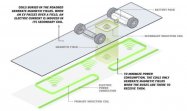Going Wireless

More than a hundred years past, Nikola Tesla examined high power electromagnetic energy transport without cables. Which raises the inquiry: Why would Elon Musk, now's bid of the Tesla fire, be investing significantly more than 0-million in a community of Supercharger stations that nevertheless require that you plug in [November 2013]?
The response is the fact that Nikola's wireless theory is not fairly prepared for electric car use. The scientific theory he worked, inductive coupling, utilizes the magnetic flux encompassing a main coil to create an electric current within an adjoining secondary coil without any physical contact involving both.
Factorization in an additional principle, magnetic resonance, permits inductive coupling to be scaled-up to higher-power amounts. The magnetic fields are being configured by the important linking both coils to work on a typical natural frequency. A charging system-so ordered has kept 30 electrical buses running in Genova and Torino, Italy, for higher than 10 years. The system's German producer, Conductix Wampfler, maintains a 95-% energy-transport efficacy, no climate-related problems, and longer battery existence attributable to the regular charging cycles. And also the bus floorings are insulated to help keep the magnetic fields from intruding with other electronics as well as pacemakers.
LIKE VELOCITY 2, BUT USING A BUS
They will not, when the rate of KAIST's electrical buses falls below 50 miles per hour burst, however they do not require to arrive at a stop merely to fill up their Here's the way the institute's on the go bus charging functions.
These wireless charging methods mark advancement toward the greatest target: recharging EVs as they roll-down the trail. KAIST expects to increase its program to several buses in 2013.
During our Tesla Design S versus Ford Design T race [February 2014], early technology virtually won because the 21st century electrical car was parked for pretty much 10 hrs of battery-charging. In our current evaluation of six electrical cars ["Field of Goals," March 2014], we invested five hrs billing for every hour of driving. This beginning-quit palsy is why electrical cars are sluggish to catch on--they signify nearly half a percentage of vehicles offered in the U.S. But visualize an electrical highway outfitted to re-charge autos cruising at 70 miles per hour. Smaller, more affordable, and lighter batteries would suffice. Automatic toll charge could cover the total cost of the electricity use up along with the inherent infrastructure.
So how long can it consider this electric car redemption to get there? Katie Corridor, chief engineering officer at WiTricity Company, a radio-charging leader, anticipates the technologies to be prepared by 2020 and maybe earlier for dedicated bus lanes, like university-campus and airport routes.


Go Motors Blog
Top 10 Best Chevrolet Models of All Time
9 Unique Ways to Customize Your Car
How to Find the Best Tow Truck Companies
Car Repair at Home: 4 Easy DIY Fixes That Anyone Can Do
6 Effective Maintenance Tips for Car Headlights
The Most Valuable Parts on a Car to Scrap
Your Guide to the New Skyactiv-X Engine from Mazda
How to Diagnose Severe Car Problems (Even When You Don’t Know Anything About Cars)
5 Tips for Finding a Good Mechanic You Can Trust
View All Recent Posts
New Photo Galleries
LATEST NEWS
-
Three Methods to Make Purchasing a Business Car Easy and Cost-Effective
-
How an Auto History Check will Protect you From Fraudulent Sellers
-
The Financial Benefits of Short Term Car Insurance for Business Users
LATEST CAR REVIEWS